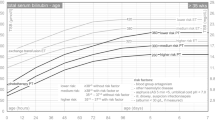Abstract
Guidelines for management of newborn hyperbilirubinemia have existed in Russia for many years. We sought to determine the degree to which management of hyperbilirubinemia in Russia meets three existing clinical protocols. We performed a cross-sectional chart review in a government-run, academic hospital in an urban setting in Moscow, Russia. Subjects were admitted to Level II nursery at Hospital No.13, were not transferred to a Level III nursery, did not die during hospitalization, and had at least one pairing of total serum bilirubin (TSB) and clinical evaluation of jaundice. We measured physician adherence to three available guidelines based upon TSB levels at which phototherapy and exchange transfusions were performed. We identified 594 infants and 1,924 pairings. Despite availability of TSB to inform decision-making, physicians did not follow the protocols. Under Russian and U.S. guidelines, physicians often failed to start phototherapy, started phototherapy unnecessarily, and missed recommended exchange transfusions. Despite a resource-poor setting, guideline adherence in Russia was remarkably similar to that of U.S. physicians. The data illustrate the challenge of overcoming physician behavior to standardize practice, and raise questions about the presumed higher quality of care in a more developed medical system. A new framework for guideline implementation is needed, and many of the necessary tools already exist.

Similar content being viewed by others
References
Agarwal R, Deorari AK (2002) Unconjugated hyperbilirubinemia in newborns: current perspectives. Indian Pediatr 39:30–42
American Academy of Pediatrics (AAP) Jaundice and Your Newborn. From http://www.aap.org/bst/showdetl.cfm?&DID=15&Product_ID=4226. Accessed November 27, 2007
American Academy of Pediatrics (2004) Management of hyperbilirubinemia in the newborn infant 35 or more weeks of gestation. Clinical practice guidelines. Pediatrics 114(1):297–316 doi:10.1542/peds.114.1.297
American Academy of Pediatrics, Provisional Committee for Quality Improvement and Subcommittee on Hyperbilirubinemia (1994) Practice parameter: management of hyperbilirubinemia in the healthy term newborn. Pediatrics 94:558–562
Association of Women’s Health obstetric and Neonatal Nurses (AWHONN), Hyperbilirubinemia presentation package. From http://www.awhonn.org/awhonn/product.detail.do?productCode=HNPP-CD-2NDI. Accessed November 27, 2007
Atkinson LR, Escobar GJ, Takayama JI et al (2003) Phototherapy use in jaundiced newborns in a large managed care organization: do clinicians adhere to the guideline? Pediatrics 111(5):e555–e561 doi:10.1542/peds.111.5.e555
BiliTool from http://www.bilitool.org/. Accessed November 27, 2007
Centers for Disease Control and Prevention (CDC) Jaundice/kernicterus—health care professionals. From http://www.cdc.gov/ncbddd/dd/kernicterus/ker_healthcare.htm. Accessed November 27, 2007
Children’s Hospital of Pittsburgh Severe Neonatal Jaundice: Causes, Care, Outcome, Prevention. Sept 21, 2006. From http://www.or-live.com/cpi/1555/. Accessed November 27, 2007
Ebbesen F, Anderson C, Verder H et al (2005) Extreme hyperbilirubinaemia in term and near-term infants in Denmark. Acta Paediatr 94(1):59–64 doi:10.1080/08035250410022170
Fetus and Newborn Committee (1999) Canadian Paediatric Society, Approach to the management of hyperbilirubinemia in term and newborn infants. Paediatr Child Health 4(2):161–164
Gartner LM, Herrarias CT, Sebring RH (1998) Practice patterns in neonatal hyperbilirubinemia. Pediatrics 101(1 Pt 1):25–31 doi:10.1542/peds.101.1.25
Ip S, Chung M, Kulig J et al (2004) An evidence-based review of important issues concerning neonatal hyperbilirubinemia. Pediatrics 114(1):e130–e153 doi:10.1542/peds.114.1.e130
Johnson LH, Bhutani VK, Brown AK (2002) System-based approach to management of neonatal jaundice and prevention of kernicterus. J Pediatr 140(4):396–403 doi:10.1067/mpd.2002.123098
Keren R, Bhutani VK (2007) Predischarge risk assessment for severe neonatal hyperbilirubinemia. Neoreviews 8:68–76 doi:10.1542/neo.8-2-e68
Maisels MJ, Kring E (2006) Transcutaneous bilirubin levels in the first 96 hours in a normal newborn population of >35 weeks’ gestation. Pediatrics 117(4):1169–1173 doi:10.1542/peds.2005-0744
Newman TB, Liljestrand P, Escobar GJ (2003) Infants with bilirubin levels of 30 mg/dL or more in a large managed care organization. Pediatrics 111(6 Pt 1):1303–1311 doi:10.1542/peds.111.6.1303
Perinatal Quality Improvement Panel (PQIP) California Perinatal Quality Care Collaborative (CPQCC) Severe Hyperbilirubinemia Prevention (SHP) Toolkit. Nov 19, 2005. From http://www.cpqcc.org/Documents/hyperbili/SHP10-19-05.pdf. Accessed November 27, 2007
Petrova A, Mehta R, Birchwood G et al (2006) Management of neonatal hyperbilirubinemia: pediatricians' practices and educational needs. BMC Pediatr 6:6 doi:10.1186/1471-2431-6-6
Author information
Authors and Affiliations
Corresponding author
Additional information
Note
The Volodin guideline is currently under consideration by Russia’s public health department as a universal, national guideline. This study provided supporting data for this proposed policy change.
“What is already known on this topic”
Neonatal jaundice is a universal problem that affects large numbers of newborns all over the world. Several countries have developed clinical guidelines, but data on physician adherence is scarce. Russian physicians have long had two local guidelines and, since 2004, the most recent AAP guideline.
“What this study adds”
This study is the first to show data of guideline adherence in Russia and to compare it to US data. Poor guideline adherence regardless of the level of resources available questions the quality of care delivered in every setting. More importantly, this study shows that implementation of hyperbilirubinemia guidelines is lacking, and that the current approach may be misdirected.
Competing interests
The authors have no competing interests to disclose.
Exclusive license
The Corresponding Author has the right to grant on behalf of all authors and does grant on behalf of all authors, an exclusive license (or non-exclusive for government employees) on a worldwide basis to the publisher.
Rights and permissions
About this article
Cite this article
Agulnik, A., Ryumina, I.I. & Burgos, A.E. Hyperbilirubinemia guideline adherence in Russia illustrates universal challenges. Eur J Pediatr 168, 1175–1180 (2009). https://doi.org/10.1007/s00431-008-0900-1
Received:
Accepted:
Published:
Issue Date:
DOI: https://doi.org/10.1007/s00431-008-0900-1




